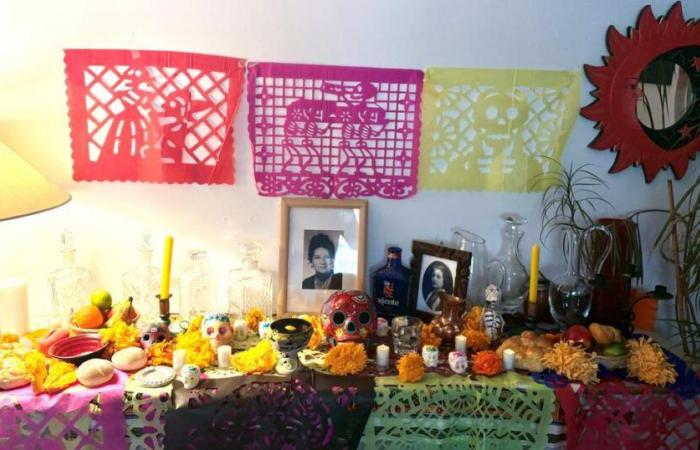
REPORTAGE – Mexicans in France, including Juan Carlos, founder of the “México à Paris” association, are building their altar to pay homage to the deceased. The festivities will take place this Saturday, November 2.
Orange flowers, colorful fruits, breads, brioches, “sugar skulls”everything is ready to decorate the altar intended to celebrate the deceased. This apartment of 20e district is imbued with a typically Mexican atmosphere. Posted next to a square wooden table, Juan Carlos, originally from Mexico and founder of the association «Mexico à Paris» is delighted to be able to begin the festivities. This graphic designer and painter has lived in France for around twenty years and never misses a year to celebrate All Souls’ Day. “El Día de Muertos” consists of paying tribute to the deceased in a festive and colorful atmosphere. Even thousands of kilometers from their country, Mexicans who live in France cannot miss it.
All Souls Day has been celebrated in Mexico for thousands of years. In many Native American communities, such as the Aztecs and the Toltecs, mourning for the dead, as it is experienced today in France, would have been perceived as a lack of respect. Among Native Americans, death constitutes a continuity of life on Earth. The deceased are therefore still part of the community.
The contemporary celebration of this “Day of the Dead” mixes Christian festivities and pre-Hispanic religious rituals. Traditionally, the celebrations begin on October 28 and last for a few days. But the D-day of the celebration is November 2, the time when the deceased descend from the world of the dead, called Mictlanto return to Earth. During this time, Mexican families gather around altars set up in their homes to honor their deceased loved ones. In the streets of Mexico, everything is decorated with flowers, paper cutouts and sugar skulls. Large costumed parades take place, and banquets are organized in cemeteries to honor the souls of the deceased.
This Mexican tradition interests as much as it fascinates. She is particularly highlighted in the film Coco, who draws inspiration from it to highlight the habits and customs of this culture. In France, it is not uncommon to come across people wearing makeup and dressed in traditional Mexican costumes during Halloween evening.
Garance De Carvalho/ Le Figaro
“It’s like celebrating Christmas without a tree”
At the center of concerns: the altar. Abundantly decorated in the living room, it constitutes the main element of the celebrations. “Celebrating El Día de Muertos without making an altar is like celebrating Christmas without a tree” says Juan Carlos Cedillo, with a Mexican accent. In his living room, a host of offerings are spread out on a rectangular tray supported by trestles, with photo frames of the deceased.
Orange flowers, known as “cempazuchitl” and recognizable by their slightly bitter smell, are used in Mexico. “It’s a way for the dead to come to us, like a road traced by the smell of flowers” confides the Mexican. Unable to find them in France, Juan Carlos made these flowers himself using orange paper, like origami, which he placed from left to right on the altar.
Another typical element straight from Mexico: skulls meticulously sculpted with sugar crystals. Fully decorated with glitter and colorful rhinestones, children can eat them at the end of the party. Juan Carlos, who does not have children, prefers to keep them carefully in a box surrounded by tissue paper for the following year. These are scattered across the entire surface of the altar, creating an impression of saturation.
To enrich this anthology of colors, very fine papers, similar to lace and made of geometric patterns, called «chopped papiers» embellish the altar. Water, salt and lit candles are also placed on this tray to purify the souls of the deceased and welcome them in good conditions. If the whole room is permeated with a strong, almost intoxicating smell of incense, it is because Juan Carlos burned a piece of «copal»a type of resin found in Mexico.
When it comes to food, there is no specific ritual. A basket filled with fruit is enough. Only tradition: bread for the dead. “The bread of the dead” is an orange-flavored brioche sprinkled with sugar whose reliefs represent bones. They are only found in Mexico, with the exception of two or three Mexican bakeries in Paris which sell them, explains Juan Carlos.
Garance De Carvalho/ Le Figaro
“My mother is coming back tomorrow”
For Juan Carlos and Mexicans, this holiday has a special meaning because it is the time when they collectively remember their deceased loved ones. Much more than one “day of the dead” it is a “love festival”, rejoices Juan Carlos. Since the death of his mother in 2003, he has made this celebration a ritual from which he does not deviate: “Every time I prepare this party, I say to myself: my mother is coming back tomorrow”.
Preparing the altar is also a moment of conviviality during which anecdotes about deceased people are told. It is a time of reminiscing and sharing happy memories, thus creating an atmosphere of closeness between members of a family. “Without the stories I told about my mother during El Día de Muertos, my nephews would never have known her,” confides Juan Carlos with emotion. The final touch to make the altar consists of adding objects that symbolize the deceased: “my mother liked tequila, so I always place this little vial on the altar,” says Juan Carlos. Everyone is free to put the objects of their choice to create a personalized touch. “For my part, I like to post letters that I wrote to him,” confides the Mexican again.
Giving importance to this celebration is also a way of considering a new relationship with death in the hope of finding a form of therapy there. “El Día de Muertos helps you grieve more easily. I would say that it gives another insight into death that makes it easier to accept.” This celebration is an opportunity to express one’s emotions without reservation in order not to bury one’s sorrow and in fine to speed up the mourning period.





